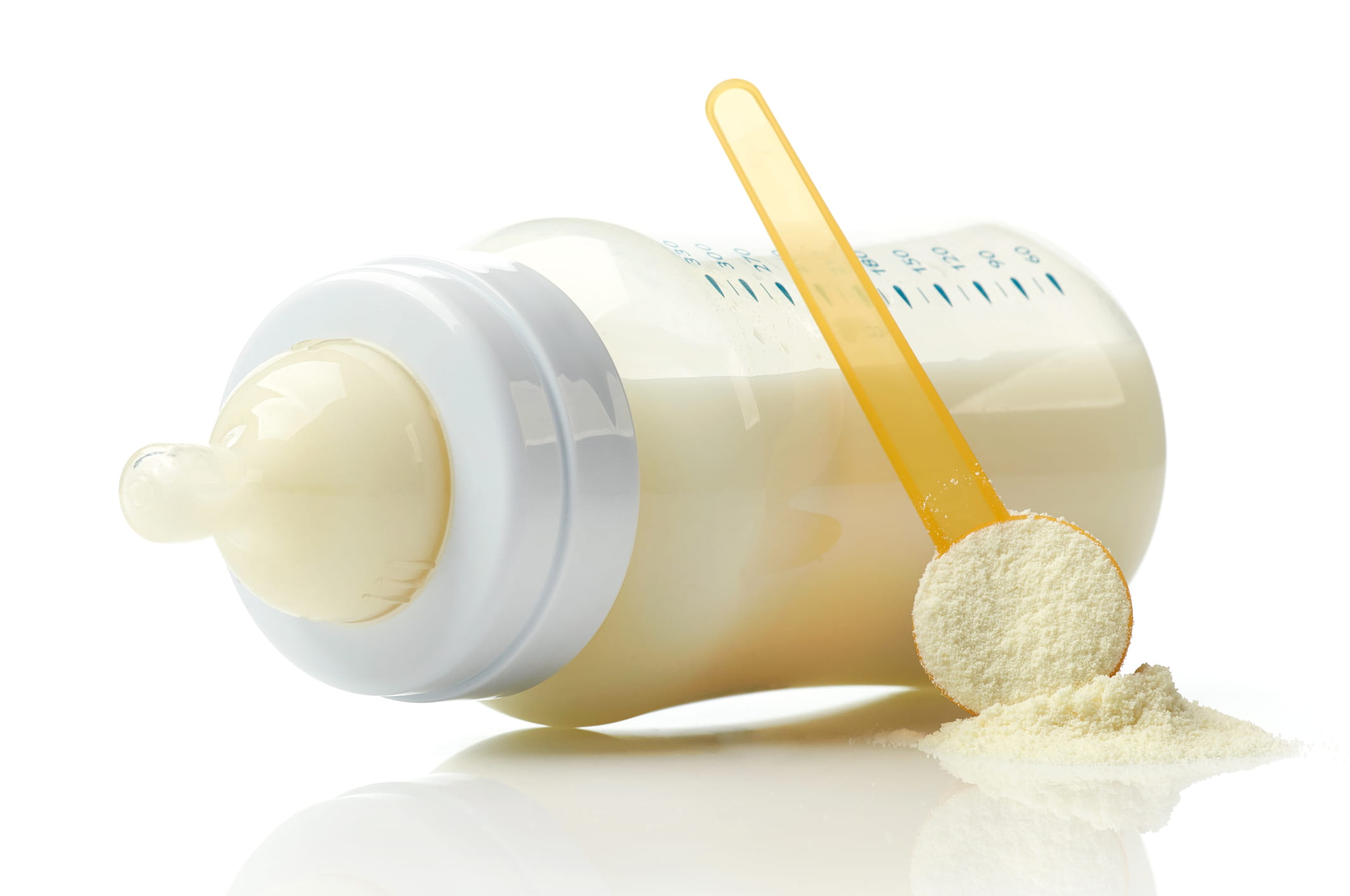Is Homemade Infant Formula Safe?

The Bottom Line
Homemade infant formulas are not regulated by the FDA and often do not meet infant nutritional needs. Babies who consume homemade infant formula can develop electrolyte imbalances and, in some cases, life-threatening diseases can occur.

The Full Story
The first infant formula was developed and sold in 1865, and by 1883 there were 27 patented brands of infant food available. Use of infant formula surged in popularity over the next century, and by the 1970’s the widespread use of infant formula in the United States caused breastfeeding rates to dip to record low numbers. Currently, approximately 75% of infants born in the United States receive infant formula at some point within the first year of life.The manufacture and sale of infant formula is a multi-billion-dollar industry in the United States. There are 3 main formula manufacturers in the United States, and store-brand or generic formulations account for only 10% of infant formula sales nationwide. Currently, commercially available infant formulas are available in powder, liquid, and ready-to-feed varieties. Infant formulas are commonly made from a cow’s milk or soymilk base, and have additional ingredients added to closely mimic the composition of human breast milk and provide other nutritional benefits. The manufacturing process for infant formula is highly regulated by the United States Food and Drug Administration (FDA) to ensure that commercially available formula products are safe and contain standard amounts of protein, lipids, carbohydrates, and vitamins. Commercially available infant formulas are not permitted to contain certain ingredients, including hydrogenated fats, fructose, and some amino acids.
Although the use of infant formula remains popular in the United States, some parents prefer to feed their babies non-traditional sources of nutrition due to financial limitations or other personal concerns. Infant formula can be costly. A one-year’s supply of name-brand (not generic) formula can cost more than two thousand dollars and may be unaffordable for many families. Some parents are concerned about the possible presence of potentially poisonous ingredients such as pesticides, bisphenol-A, and heavy metals in commercially available infant formulas, while others believe that traditional formulas are associated with impaired immunity or gastrointestinal disease. For these and other reasons, some parents choose to feed their babies homemade infant formula.
Recipes for homemade infant formula can be found online, in blogs, and on social media. These recipes are often created and promoted by individuals who are not credentialed as nutritionists or registered dieticians, and many do not provide instructions for safe handling or storage of the homemade formula preparations. The recipes may include ingredients such as raw or powdered goat’s milk, liver, and almond milk as a formula base or protein source. These alternative protein sources may not provide infants with the correct amounts of calories, calcium, or vitamin D to maintain health, and may promote the development of food allergies. The use of these ingredients in homemade infant formula can result in potentially significant adverse health effects. For example, goat’s milk contains two to three times the protein content of standard infant formula or human breast milk and also contains high levels of chloride and potassium. Infants who consume undiluted goat’s milk have developed electrolyte disturbances, anemia, and severe allergic reactions. Although commercially available infant formula is fortified with vitamin D, alternative milk products such as almond, soy, and coconut milk may not contain enough vitamin D to support healthy infant growth and development. Severe vitamin D deficiency, including rickets (a disorder of bone growth) may occur in infants who consume homemade formula made from alternative milk sources.
Supply chain challenges, in addition to infant formula recalls due to bacterial contamination with Cronobacter species, led to a national shortage of infant formula in 2022 and prompted many families to consider using homemade infant formulas as a replacement for standard formula products that were not widely available. Due to the health and safety concerns associated with homemade formula, the FDA and the American Academy of Pediatrics do not recommend the use of homemade infant formulas. However, even during a widespread formula shortage, there are safer alternatives than using homemade infant formula. In the United States, store-brand (generic) infant formulas provide nutritional support that is comparable to name-brand formulas, are significantly less costly than name-brand formulas, and are also regulated by the FDA. There are multiple varieties of store-brand infant formula including sensitive, hypoallergenic, and soy-based products. Perrigo, the manufacturer of most store-brand infant formulas available in the United States, offers a resource guide on its website to assist parents in finding store-brand formula alternatives to name-brand formula products that may be in limited supply.
For questions about food poisoning, food contamination, or recalls of food or medicines, get an immediate personalized recommendation online or call Poison Control at 1-800-222-1222. Both options are free, confidential, and available 24 hours a day.
Kelly Johnson-Arbor, MD, FACEP, FUHM, FACMT
Medical Toxicologist
Poisoned?
Call 1-800-222-1222 or
Prevention Tips
- Formula-fed infants should consume only commercially available infant formula. Do not feed homemade formula to infants.
- Talk to your baby’s pediatrician if you are unable to afford or locate infant formula, as formula samples may be available in the office.
- Give vitamin D supplementation, as directed by a pediatrician, to breastfed babies as well as formula-fed infants who consume less than 32 ounces of infant formula daily.
This Really Happened
- A 5-month-old boy was brought to a hospital after his lips turned blue and he had seizure-like movements after being fed. He had consumed cow’s milk formula since one month of age, but due to episodes of fussiness, gassiness, and constipation, his parents had recently changed his formula to a homemade version. He was admitted to a Pediatric Intensive Care Unit (PICU) where laboratory testing revealed abnormally low calcium and vitamin D levels. X-rays showed bone changes consistent with a diagnosis of rickets. He was treated with calcium and magnesium and was discharged after a 4-day hospitalization with instructions to consume cow’s milk formula and take vitamin D supplements.
- A 4-month-old boy was brought to a hospital with breathing difficulties and respiratory distress. He was lethargic, had mottled skin, and experienced multiple episodes of cardiac arrest soon after arrival at the hospital. He was resuscitated and admitted to a PICU where he was diagnosed with extremely low calcium and vitamin D levels. His family reported that he had been exclusively breastfed until 1 month of age, when his diet was changed to a homemade formula recipe that his parents had discovered on social media. He was diagnosed with rickets and was eventually discharged after a complicated 5-week hospitalization.
For More Information
References
Abrams SA, Daniels SR. Protecting Vulnerable Infants by Ensuring Safe Infant Formula Use. J Pediatr. 2019 Aug;211:201-206.Bertmann F, Dunn CG, Racine EF, Fleischhacker S. The Risk of Homemade Infant Formulas: Historical and Contemporary Considerations. J Acad Nutr Diet. 2022 Apr;122(4):697-708.
Davis SA, Knol LL, Crowe-White KM, Turner LW, McKinley E. Homemade infant formula recipes may contain harmful ingredients: a quantitative content analysis of blogs. Public Health Nutr. 2020 Jun;23(8):1334-1339.
Martin CR, Ling PR, Blackburn GL. Review of Infant Feeding: Key Features of Breast Milk and Infant Formula. Nutrients. 2016 May 11;8(5):279.
Vieira MA, Kube PK, van Helmond JL, Hanley PC, Graber EG, Bialo SR, Slamon NB. Recipe for Disaster: Homemade Formula Leading to Severe Complications in 2 Infants. Pediatrics. 2021 Sep;148(3):e2021050947.
Maines E, Gugelmo G, Tadiotto E, Pietrobelli A, Campostrini N, Pasini A, Ion-Popa F, Vincenzi M, Teofoli F, Camilot M, Bordugo A. High-protein goat's milk diet identified through newborn screening: clinical warning of a potentially dangerous dietetic practice.
Poisoned?
Call 1-800-222-1222 or
Prevention Tips
- Formula-fed infants should consume only commercially available infant formula. Do not feed homemade formula to infants.
- Talk to your baby’s pediatrician if you are unable to afford or locate infant formula, as formula samples may be available in the office.
- Give vitamin D supplementation, as directed by a pediatrician, to breastfed babies as well as formula-fed infants who consume less than 32 ounces of infant formula daily.
This Really Happened
- A 5-month-old boy was brought to a hospital after his lips turned blue and he had seizure-like movements after being fed. He had consumed cow’s milk formula since one month of age, but due to episodes of fussiness, gassiness, and constipation, his parents had recently changed his formula to a homemade version. He was admitted to a Pediatric Intensive Care Unit (PICU) where laboratory testing revealed abnormally low calcium and vitamin D levels. X-rays showed bone changes consistent with a diagnosis of rickets. He was treated with calcium and magnesium and was discharged after a 4-day hospitalization with instructions to consume cow’s milk formula and take vitamin D supplements.
- A 4-month-old boy was brought to a hospital with breathing difficulties and respiratory distress. He was lethargic, had mottled skin, and experienced multiple episodes of cardiac arrest soon after arrival at the hospital. He was resuscitated and admitted to a PICU where he was diagnosed with extremely low calcium and vitamin D levels. His family reported that he had been exclusively breastfed until 1 month of age, when his diet was changed to a homemade formula recipe that his parents had discovered on social media. He was diagnosed with rickets and was eventually discharged after a complicated 5-week hospitalization.
